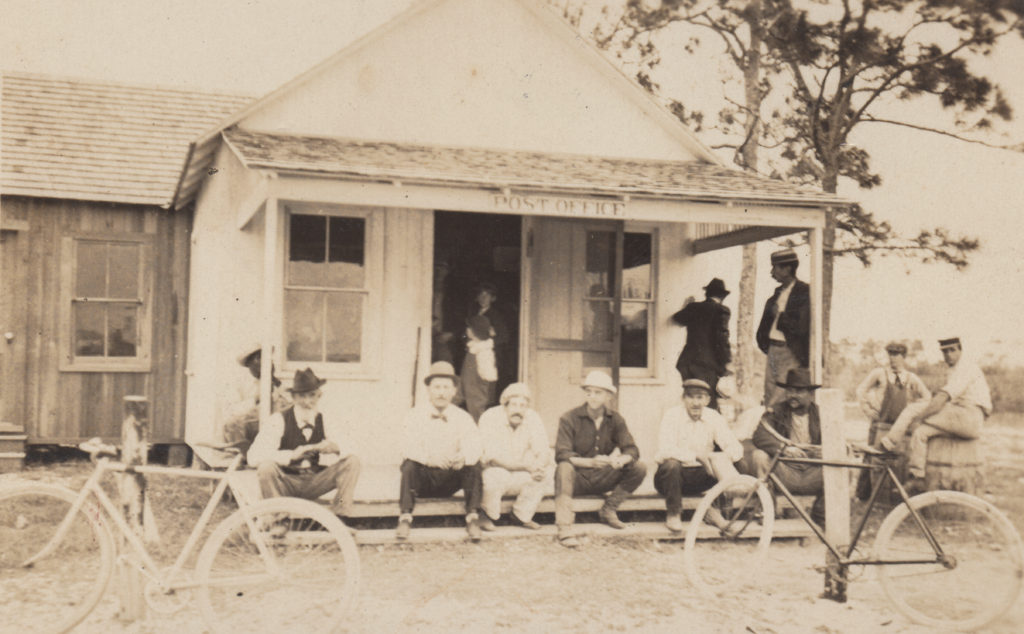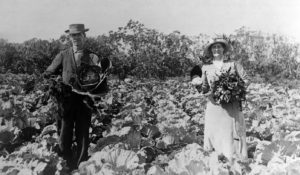- Prior to 1845, when Florida became a state, Africans, Seminole Native Americans, and Black Seminoles were already living in South Florida and continued to do so along with white Europeans.
- In 1868 William and Sara Gleason, Wisconsin natives, began purchasing thousands of acres of land in various locations in Florida including in what is now the City of Delray Beach. William Gleason was the Lieutenant Governor of Florida from 1868 to 1870. Two of their sons (W.H.H. and George) participated with them in handling real estate transactions using the business name of “Gleason Brothers, dealers in Real Estate.” Many early settlers in the area bought property from the Gleasons.
- The military maps of the peninsula of Florida dating from the 1850’s time of the Seminole Wars depict a haulover identified as Orange Grove Haulover along the beach area of what is now the City of Delray Beach. The name derived from an ancient orange grove found growing near the beach. (A haulover is a place where people traveling by boat could no longer navigate and had to haul their boats out of the water and carry them on land for a distance.)
- In 1876 The Orange Grove House of Refuge #3, a haven for the shipwrecked, was constructed by the U.S. Lifesaving Service and located just north of the ancient orange grove depicted on earlier military maps. The first Refugee-keeper was Hannibal D. Pierce.
- In 1885 Annie Andrews, wife of Stephen N. Andrews who was the second and last keeper of House of Refugee #3, established a post office address named Zion, Florida for the area now known as the City of Delray Beach.
- In 1885, Henry Flagler purchased the Jacksonville, St. Augustine and Halifax River Railway in his efforts to build a railroad to connect the entire east coast of Florida. Flagler was granted millions of acres of land from the State of Florida to use in the construction of the Florida East Coast Railway. Flagler also purchased many thousands of acres of land under the name of Model Land Company along the east coast of Florida including many hundreds of acres in the area now known as Delray Beach. Many early settlers bought land from Model Land Company. Many of the workers for Henry Flagler in the construction of his railroad were African Americans.
- In 1890 the Florida Coast Line Canal (Intracoastal Waterway) was made navigable in parts allowing for easier access to areas along the southeast coast.
- By 1894 a number of people of African descent had settled here from north Florida, other nearby southern states and the Bahamas. Their population grew as they encouraged their relatives to relocate to the area.
- In 1894 William S. Linton arrived in the area from Michigan with David Swinton and Major Nathan Boynton. At that time, William Linton was a U. S. Congressman for the State of Michigan, serving from 3/1893 to 3/1897. Congressman Linton bought tracts of land from Henry Flagler’s Model Land Company, the Gleasons and others. The following year Congressman Linton returned with a group of almost a dozen people, including civil engineer E. Burslem Thompson and named the town Linton.
- In 1894 the first school was established in Linton. It was established by the African American settlers. The African-American community was large enough to petition Dade County for a school. (This area was then a part of Dade County until 1909 when Palm Beach County was established) That school, known as “(Dade County) School #4, Colored),” was located in Linton on Blackmer Street, currently known as North- west “Historic 5th Avenue.” As with many such pioneer schools, it is thought to have been built with palmetto fronds.
- In 1895 the plat map of the Town of Linton, including about a mile along the beach, was drawn by E. Burlsem Thomson, a civil engineer in Congressman Linton’s group. Atlantic Avenue was platted next to a rock wall partially surrounding the ancient orange grove. Development of the Town of Linton began.
- In 1895 Adolf Hofman, a German native of a prosperous farming family arrived in the United States from Germany spending a few weeks in New York and then on to Illinois for a few months. Later that year, he traveled to Florida to purchase land for farming. He traveled to this area on the same barge with Linton’s group and first bought land from Flagler’s Model Land Company in 1896. That land was located north of NE 4th Street (north of Linton’s property) and stretched westward from the “canal” (Intracoastal) to Swinton Avenue and included land that is now known as Del Ida Park Subdivision. The Hofman family homestead was east of N.E. Seventh Avenue near NE 6th Street. Shortly thereafter, Hofman bought land from Congressman Linton and Gleason and later bought land from others.
- In 1896 the original plat for the Town of Linton was officially recorded.
- In 1896 the first church in Linton, Mt. Olive Baptist Church, was established. It was established by African American settlers.
- In 1896 Henry Flagler’s Florida East Coast (FEC) Railway route was completed through the Town of Linton. The railroad and the local depot were essential for the farming economy and the growth of the town.
- By 1896 African descendant Mary Cohen (aka “Auntie” Cohen and “Ma” Cohen), a trained midwife, had settled in Linton and was the midwife for the birthing of babies of all races.
- In 1897 the second church in Linton, St. Paul African Methodist Episcopal (AME) Church, formerly named Mt. Tabor was established. It was established by African American settlers.
- Between 1896 and 1898 a school was established by white settlers for children of European descent. This school was located at the site of what is now Old School Square.
- By 1898 Susan Williams, a trained midwife and general nurse practitioner of African descent had arrived from the Bahamas and handled medical needs of all races of people of Linton.
- In 1898 the name of the Town of Linton was changed to “Delray” following hardship brought on by crop-destroying freezes and William Linton’s default on his land payments. W.W. Blackmer, a town leader suggested the name “Delray” which was derived from the name of a town located near Detroit, Michigan.
- In 1902 the Ladies Improvement Association was established. This small group of women spearheaded projects for many of the town’s amenities that were later achieved through the years such as a cemetery, the public library, Atlantic Avenue improvements, and a town hall.
- In 1903 the church now known as Cason United Methodist Church was established by and attended by settlers of European descent.
- In 1903 hurricane winds wrecked the British ship, SS Inchulva, near the south end of Delray’s municipal beach. Early settlers of African descent who emigrated from the Bahamas initiated the rescue of the survivors.
- In 1904 Trinity Evangelical Lutheran Church (originally called Evangelishe Lutherische Dreienigkeits Gemeinde by German settlers) was established. Adolf Hofman and other pioneer families of German descent were founding members.
- In 1904 “Yamato” was established as a Japanese agricultural colony south of Delray. Jo Sakai, the leader, named the colony “Yamato,” an ancient name revered in Japan. The first group of Japanese settlers were recruited by Henry Flagler and were all men. In later years, their wives and children and some of their relatives and friends joined them including George Morikami for whom the Morikami Museum and Japanese Gardens in Delray Beach is named for which he donated more than 200 acres of land. The Japanese early settlers came to Delray for shopping, recreation and participation in civic events. Their children attended grade school in Yamato, but came to Delray to attend high school at Delray High School.
- In 1904 Missionary Bishop Rt. Rev. William Crane Gray held the first service in the new St. Paul’s Episcopal Church which was for settlers of European descent.
- In 1905 Delray’s first parochial school (Deutsche Schule) known as the German School was established by Trinity Lutheran Church.
- In 1908 telephone service became available.
- In 1909 Palm Beach County was created from the northern portion of Dade County.
- The population of Delray was first counted in the 1910 U.S. Census. The total recorded population was 904. A high percentage of working residents listed occupations related to farming or fishing. At least a dozen small farms were owned by African Americans. (The Tropical Sun newspaper remarked in 1908 that “this number is expected to expand significantly.”) A group of 49 Bahamians and their families operated a fishing camp on the beach. A slim majority (52%) of the population were white; although many were native Floridians or had come from nearby southern states, a significant number had immigrated from the Midwest and Northeast, with the state of Michigan topping the list. Quite a few residents listed their nationality as first- or second-generation German.
- In 1911 the area west of the “canal” (Intracoastal Waterway) was incorporated as the “Town of Delray.” John Shaw Sundy became the first Mayor and served seven terms.
- In 1911 Missionary Bishop Rt. Rev. William Crane Gray, along with about a dozen men and women settlers of African descent who emigrated from the Bahamas, organized St. Matthews Episcopal Church.
- In 1911 the first bridge was built over the canal, connecting the barrier island with the Town of Delray.
- In 1913 the Delray Beach Library was founded by the Ladies Improvement Association.
- In 1913 a new Delray Elementary and High School building was constructed. The building now houses the Cornell Museum of Art and History at Old School Square.
- In 1914 the Town of Delray passed the first bond issue and the first city electric and water plants were built.
- In 1923 “The Town of Delray Beach,” the area east of the Intracoastal, was incorporated.
- In 1925 a new separate building for the Delray High School was constructed. The building is now the Crest Theatre at Old School Square.
- On May 11, 1927, the two incorporated towns – Town of Delray Beach and the City of Delray – united to form “The City of Delray Beach.”




